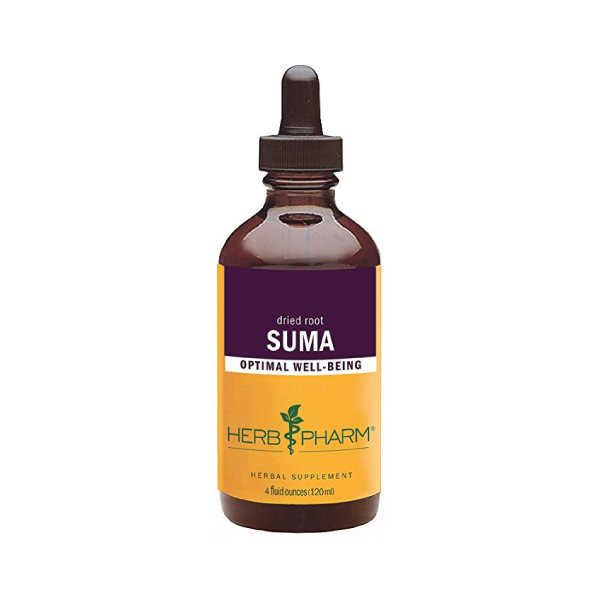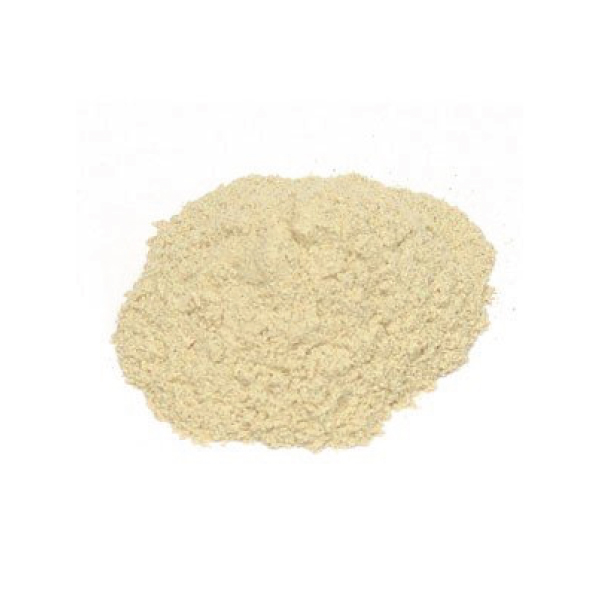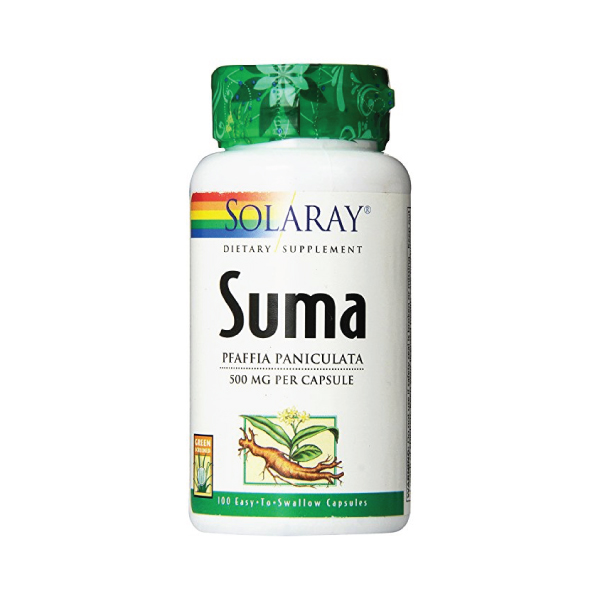What is Suma?
Suma is an adaptogenic root herb from the Amazon basin.
In fact, suma is considered one of the best all-rounders you'll find in South America.
In traditional systems, this herb was used as a sort of "cure all." Its common name in the region is "para toda" which translates to "for all things."
Suma is often referred to as Brazilian Ginseng due to the fact that it has many of the same uses as ginseng (general adaptogenic). Additionally, both plants use the same part of the plant — a large taproot.
Suma has no close family relations to ginseng — they are entirely different plants.
The high saponin content of suma has been shown to have a wide range of activities on the immune system, metabolism, the production of new blood cells, and hormonal regulation.
We're likely to see more of suma in the near future as a health supplement and superfood due to its powerful adaptogenic benefits.
Most of its constituents are water-soluble — which means the best way to use the herb is as a tea or in capsules.
What is Suma Used For?
Suma has many uses, the most common include; immune dysfunction (asthma, rheumatism, allergies, and inflammation), metabolic dysfunction, adjunct cancer therapy, low testosterone, anemia (especially sickle cell), general pain and inflammation.
This herb is especially useful during recovery after injuries involving blood loss, and various forms of anemia — including sickle cell anemia.
Traditional Use of Suma
Pfaffia paniculata is also referred to as "para toda" (means "for all things"), and "Brazilian Ginseng."
The common names for Pfaffia paniculata reflect its broad spectrum of medicinal benefits and applications in traditional Peruvian medicine — such as a sexual tonic, general health tonic, vulnerary, antibacterial, and ulcers of the skin and digestive system [9].
In Brazil, Pfaffia paniculata is used for anemia, arthritis, asthma, cancer, chronic fatigue syndrome, circulation problems, diabetes, Epstein-Barr, hypertension, hyperglycemia, immune disorders, impotence, inflammation, leukemia, lymphatic diseases, mononucleosis, pain, rejuvenator, rheumatism, skin problems, stress, tranquilizer, tremors, tumors, ulcers, and as an aphrodisiac, appetite stimulant, and antioxidant [9].
Herb Details: Suma
Herbal Actions:
- Adaptogenic
- Anti-cancer
- Antidiabetic
- Chemoprotective
- Hepatoprotective
- Immunomodulator
- Neuroprotective
- Vulnerary
- Antimicrobial
Weekly Dose
- (1:2 Liquid Extract)
1045 mL - View Dosage Chart
Part Used
- Root
Family Name
- Amaranthaceae
Distribution
- South America — Amazon rainforest
Constituents of Interest
- Pfaffic acids
- Ecdysteroid glycosides
- Pfaffosides A, B, C, D, E, and F
- Allantoin
Common Names
- Brazilian Ginseng
- Pfaffia
- Para Toda
- Corango-acu
Duration of Use
- Avoid long-term use in therapeutic doses.
Products Containing Suma
Botanical Information
Pfaffia paniculata is sometimes included under the name Hebanthe eriantha — both are synonymous and refer to the same plant.
Suma is a large, rambling shrubby ground vine. The roots grow deeply, and extensively, forming a large taproot. This is the part we use as medicine.
Suma is a member of the Amaranthaceae family of plants, placing it in relation to spinach, beet, and quinoa.
Pharmacology & Medical Research
+ Adaptogen
The term "adaptogen" refers to plants or other substances that augment non-specific resistance in the body, and help the body to adapt to various situations. Therefore protecting it from stressful events and factors. [7].
A research study investigating the literature of 24 books in Brazil, looking for indications of adaptogenic plants from the region, that are listed in more than 4 books, found that pfaffia was one of the most utilized tonic botanicals in Brazil, but was listed in fewer than four books. This study did, however, suggest its classification as an adaptogen despite not meeting their four book minimum reference, and has alluded to studies on the herb promoting this classification [7]. Not only is pfaffia one of the most utilized tonic herbs in Brazil, but in other parts of the world this herb has been incorporated into many commercial preparations for such uses as adaptogenic blends, muscle and athletic performance enhancers, adrenal supportive, aphrodisiac blends, female and male tonics, and immune system support supplements [5].
Other studies have shown effects from this botanical that normalize sex hormones, offer chemoprevention (cancer prevention), and lower cholesterol in the body [2, 6, 8, 9,].
Pfaffia contains β-ecdysterone and ecdysteroid glycosides, which have been closely associated with adaptogenic botanicals. They are poorly understood, and most of them are rapidly catabolized, making in vivo studies more difficult. This class of molecules is considered steroid hormones, which has a variety of effects some of which include hormonal modulation. They are not thought to bind directly to hormone receptors in mammals but do have an influence over hormone levels through an unknown mechanism. They have also been suggested to be useful in gene-therapy [5].
Other scientifically validated effects of ecdysteroids includes:
- Growth stimulation
- Accelerated bone healing
- Improved wound healing
- Anti-aging effects on skin
- Inhibition of psoriasis
- Increased milk production
- Stimulates protein synthesis in the liver
- Increases glycogen content in various organs (heart, liver, muscles)
- Antidiabetic effects
- Cholesterol reduction
- Prevents lipid peroxidation
- Neuromodulatory on GABA receptors
- Antiepileptic effects
- Protective effects against amnesia induced by alcohol and diazepam
- Antiarrhythmic
- Restores normal fibrinogen concentration and viscosity of blood
- Counteracts adverse effects from TNF alpha on endothelial cells
- Improves liver regeneration
- Stimulates bile secretion
- Anti-inflammatory
- Restores normal glomerular filtration rate in the kidneys and suppresses albuminuria
- Protects gastric mucosa
- Enhance DNA synthesis
- Inhibits histamine release from mast cells
- Promotes thymus function
- Stimulates T-cell CD2 presentation
- Antibacterial
- Antifungal (Source — 5)
Ecdysterone is also found in black ant, which to no surprise has very similar uses to pfaffia.
Pfaffia paniculatas long-standing use as a general tonic, sexual tonic, and very low toxicity, all suggest its use as an adaptogen. One of its common names "para toda" means "for all things" in Spanish, it alludes to pfaffia's broadpfaffia's actions and uses for a wide variety of conditions.
Adaptogens are often used in this way as they tone the body, and increase resistance to various kinds of stress. They are often considered all-purpose herbs. Other examples of adaptogens are ginseng, reishi, eleuthero (Siberian ginseng), gynostemma, and cordyceps.
+ Analgesic
Taylor L. (2005) refers in her book to several studies done on Pfaffia on mice demonstrating analgesic, and anti-inflammatory effects in vivo [9].
+ Anemia
In 1995 a U.S. patent was filed that included information on pfaffia regarding its effects on sickle cell anemia. Researchers reported that patients taking pfaffia over the course of three months (1000 mg, 3 times a day), had increased hemoglobin levels, inhibited red blood cell sickling, and improved physical condition. These effects were noted to be statistically higher than the placebo control group. It was also noted however that once the treatment stopped, patients returned to the pre-treated state.
There were notably several patients who remained on the treatment after the study for 3 or more years afterward with no recorded side effects, and a showed consistent improvement [9]. Ballas (2000) [1], discovered that "Pfaffia paniculata functions as a sodium ionophore on sickle cells, and improves their hydration status, and rheological properties" (p. 359).
+ Cancer
Saponins contained within Pfaffia paniculata named pfaffosides have been clinically demonstrated to inhibit cultured tumor cell melanomas (in vitro) [9]. These same saponins as well a pfaffic acid were the subject of several Japanese patents in the 1980s for their anti-tumor effects. One of the patents suggested evidence to support 100 mg/kg of pfaffia saponins orally in rats was active against gastric cancer.
Other patents showed evidence that pfaffic acids provided strong (in vitro) activity against melanoma, liver carcinoma, lung carcinoma cells at a dose of 4-6mcg pfaffic acids (equates to about 400-600g natural pfaffia root) [9]. These doses are quite high, and therefore in these cases, an extract will need to be standardized and used, or else these chemicals will need to be synthesized in order to achieve the doses listed.
A different study done in Japan measuring the anticancer activity of Pfaffia showed evidence that powdered Pfaffia root (at a dose of 750mg/kg) was able to inhibit the proliferation of lymphoma and leukemia in mice (in vivo). The effect of Pfaffia root was able to slow the growth of cancer, but not kill it completely. The researchers in this study suggested that the inhibitory effects may have been produced by -non-specific, enhancement of the immune system [9].
Pfaffia paniculata has been shown to be antineoplastic and chemoprotective in mice with hepatocarcinogenesis [2]. That same study noted that both the butanolic extract and powdered root extract (6:1) (methanol and ether) provided antineoplastic effects on tumors in vivo (mice).
Pfaffia has been shown to inhibit angiogenesis (vascularization of tumor cells) in high doses [2]. If angiogenesis in tumor cells can be inhibited, this has direct effects on the growth rate of the tumor.
It has been noted often in the scientific literature, that the most effective anticancer actions are demonstrated by agents with multiple effects including inhibition of proliferation, modulation of apoptosis, and protection of intercellular communication (through gap cells, possibly by modulation of connexin). Many neoplastic cells alter connexin expression, thereby lowering the effectiveness of these gap junctions, and thus intracellular communication. It has also been noted in various studies on different plants that saponins often have notable effects on tumor apoptosis, and tumor proliferation inhibition, and some increase intracellular communication. The saponins in Pfaffia paniculata are similar to these anti-tumor saponins.
P. paniculata extracts have been shown to induce apoptosis, and inhibit cell proliferation and angiogenesis in hepatocarcinoma in mice, but were not found to be related in any way to the support of intracellular communication between cells [8]. This suggests possible synergy with botanicals shown to act on connexin, or otherwise improve the gap junctions of cells to increase intracellular communication through these junctions. The mechanism by which these saponins may be producing these actions is likely due to inhibition of the proteins responsible for this cellular division (cyclin-dependent kinases) as found in Panax saponins. The author would like to suggest possible synergy between Pfaffia paniculata and Panax spp.
For similar functions on chemoprotection/chemoprevention, with added benefits from both. It is well known throughout medical science as well as traditional medical systems that the use of substances with combined synergy is often more effective than single herbs or substances.
The effects produced by Pfaffia paniculata (apoptosis, inhibition of tumor proliferation were suggested to offer preventative effects on cancer as well as treatment [8].
+ Hypercholesterolemia
β-sitosterol and stigmasterol have been shown to inhibit cholesterol absorption, which in turn mildly suppresses plasma concentrations of cholesterol [6].
+ Aphrodisiac
Taylor L. (2005) notes that Pfaffia was shown to increase sexual performance in healthy, sexually sluggish, and impotent rats. She also refers to a U.S patent, that was filed on a multi-plant combination containing Pfaffia for sexual enhancement in humans, this patent indicated that the pfaffia extract tested increased sexual performance and function [9].
This increase in sexual function is suggested to be due to an increase in sex hormones. In males, testosterone is the primary androgen and plays a critical role in male sexual organs development and function. It is synthesized in the Leydig cells in the testes, which is stimulated by luteinizing hormone. Pfaffia paniculata has been shown to increase this hormone significantly in mice consuming powdered Pfaffia paniculata root in water daily, with no side effects or signs of toxicity [3, 6]. In females, the same powdered root was shown to increase estradiol, and progesterone in female mice significantly. These effects have been noted to likely be due to the ecdysteroids contained within various Pfaffia species [5].
+ Hormonal Modulation
In a study done on mice [6], using powdered Pfaffia paniculata (confirmed to contain pfaffic acid, β-sitosterol, stigmasterol, allantoin, saponins, β-sitosteryl-β-D-glucoside, and stigmasteryl-β-D-glucoside) researchers found an increase in estradiol, and progesterone levels in female mice, and testosterone levels in male mice. The mechanism of action has yet to be determined, although these effects have been documented in several studies, and would explain the actions of many of its suggested uses. This study also reported that this herb was safe to consume over long periods, producing no notable side effects or hormone imbalances. This further suggests an adaptogenic classification of this herb.
The testosterone-enhancing effects showed the greatest improvement [6].
Phytochemistry
Taylor L. (2005), states that “Nutritionally, pfaffia root contains 19 different amino acids, a large number of electrolytes, trace minerals, iron, magnesium, zinc, vitamins A, B1, B2, E, K, and pantothenic acid.
The root is high germanium content probably accounts for its effects on oxygenation. Suma root also contains novel phytochemicals including saponins, pfaffic acids, glycosides, and nor-triterpenes”.
The high iron content may account for its traditional use for anemia (more recent research has discovered Pfaffia affects sodium in blood cells to rehydrate them as well).
Pfaffia paniculata contains stigmasterol, sitosterol (and their glycosides allantoin, pfaffic acid, and saponins called pfaffosides A, B, C, D, E, and F) [3]. The saponin content, in particular, is reported to be quite high in this plant (up to 11%) [9], which has been associated with adaptogenic plants in many other cases and provides a broad spectrum of effects including anti-cholesterol, anticancer, and antimicrobial.
Pfaffia also includes β-ecdysterone (0.63%) and ecdysteroid glycosides, which have been attributed to many of its benefits, and adaptogen like effects, hormone modulatory effects, and athletic performance, among others [5, 9].
The main plant chemicals of suma are: allantoin, β-ecdysterone, β-sitosterol, daucosterol, germanium, iron, magnesium, nortriterpenoids, pantothenic acid, pfaffic acids, pfaffosides A, B, C, D, E, and F, polypodine B, saponins, silica, stigmasterol, stigmasterol-3-o-β-d-glucoside, vitamins A, B1, B2, E, K, and zinc [9].
Clinical Applications Of Suma:
Suma is a long term, chronic condition herb. It is best used alongside other therapies and herbs to build the system.
Suma is adaptogenic and directly improves both the immune system and metabolism. This makes suma useful for adjunct therapy alongside other treatments for cancer, autoimmune disease, and diabetes.
One of the most specific uses suma has is for sickle cell anemia. Suma is likely the best treatment available when it comes to this specific condition.
Cautions:
Suma has very low toxicity, even at high doses and long term use.
However, due to the high saponin levels within this plant, care must be taken if consuming large doses. Saponins have been known to cause gastrointestinal disturbances in excessive amounts [9].
Synergy
Panax spp. (similar actions, Panax offers an extra mechanism of action on chemoprevention through its effects on the gap junctions, and thus intracellular communication).
Possible synergy with other immunomodulators (cat's claw, reishi, chaga, etc.), and with herbs supporting the gap junctions of cells for chemoprevention.
Recent Blog Posts:
References:
Ballas, S. K. (2000). Hydration of sickle erythrocytes using a herbal extract (Pfaffia paniculata) in vitro. British Journal of Haematology. doi:10.1046/j.1365-2141.2000.02276.x
Carolina Scarpa Carneiro, Katia Cristina, Marcia Kazumi, Gokithi Akisue, Tereza Cristina da Silva, Maria Lucia Zaidan Dagli, Frederico Azevedo Costa-Pinto, Silvana Lima Gorniak, Ana Paula da Silva, Patrı́cia Matsuzaki, Mitsue Haraguchi. (2007). Pfaffia paniculata (Brazilian ginseng) methanolic extract reduces angiogenesis in mice. Experimental and Toxicologic Pathology. 58. 427-431. doi:10.1016/j.etp.2006.11.005
Chauhan, N. S., Sharma, V., Dixit, V. K., & Thakur, M. (2014). A review on plants used for Improvement of Sexual Performance and Virility. Biomed Research International, 2014.
Luiz Rodrigo Saldanha Gazzaneo, Reinaldo Farias Paiva de Lucena and Ulysses Paulino de Albuquerque. (2005). Knowledge and use of medicinal plants by local specialists in an region of Atlantic Forest in the state of Pernambuco (Northeastern Brazil). Journal of Ethnobiology and Ethnomedicine. 1:9. doi:10.1186/1746-4269-1-9
Lafont R, Dinan L. (2003). Practical uses for ecdysteroids in mammals including humans: an update. Journal of Insect Science. 3. 7.
Masami oshima, and Yeunhwa Gu. (2003). Pfaffia paniculata-induced changes in plasma estradiol-17β, progesterone and testosterone levels in mice. Journal of Reproduction and Development. 49. 2. 175-180.
Mendes, F. R., & Carlini, E. A. (2007). Brazilian plants as possible adaptogens: An ethnopharmacological survey of books edited in Brazil. Journal of Ethnopharmacology, 109(3), 493-495. doi:10.1016/j.jep.2006.08.024
Silva, T. C., Cogliati, B., Silva, A. P., Fukumasu, H., Akisue, G., Nagamine, M. K. Dagli, M. L. (2010). Pfaffia paniculata (Brazilian ginseng) roots decrease proliferation and increase apoptosis but do not affect cell communication in murine hepatocarcinogenesis. Experimental and Toxicologic Pathology. doi:10.1016/j.etp.2009.03.003
Taylor, L. (2005). The healing power of rainforest herbs: A guide to understanding and using herbal medicinals. Garden City Park, NY: Square One Publishers.














As COVID-19 continues to spread around the world, we’re getting a lot of questions on what the potential role of herbal medicine is during the outbreak. Learn how the virus works and how to limit your chances of transmission.